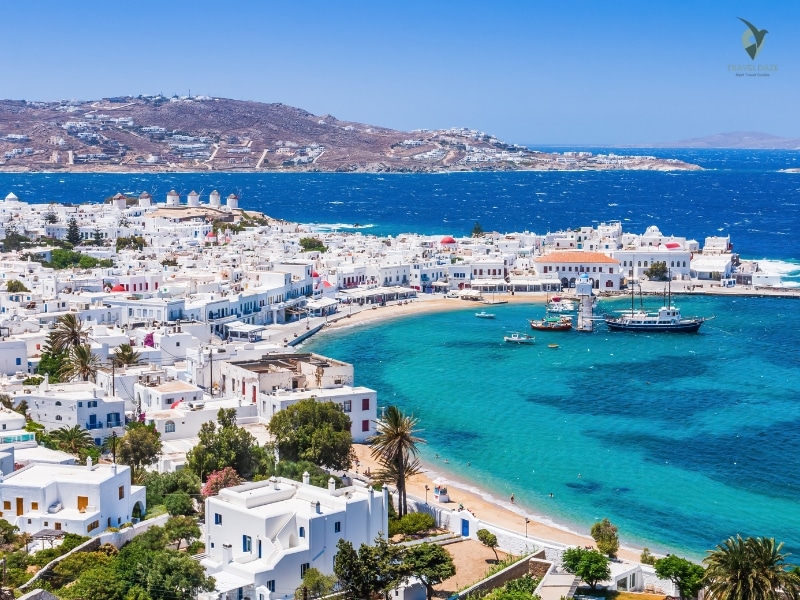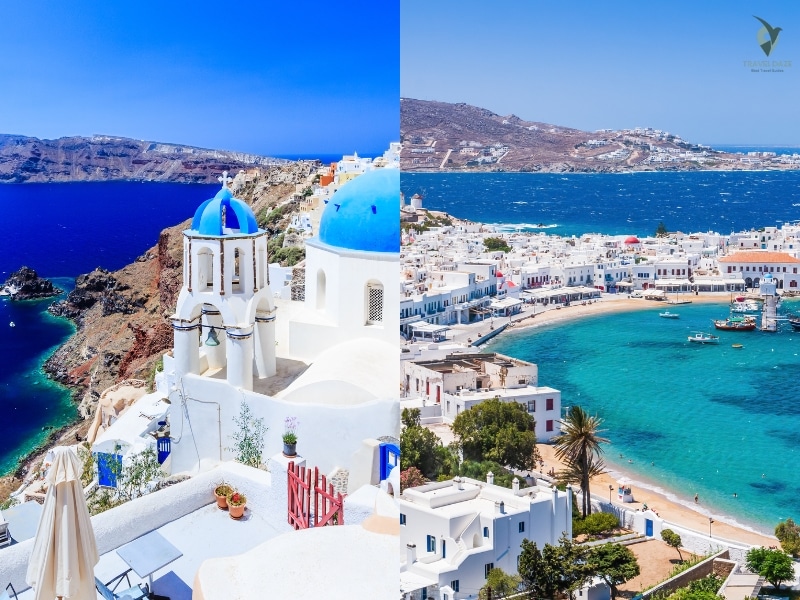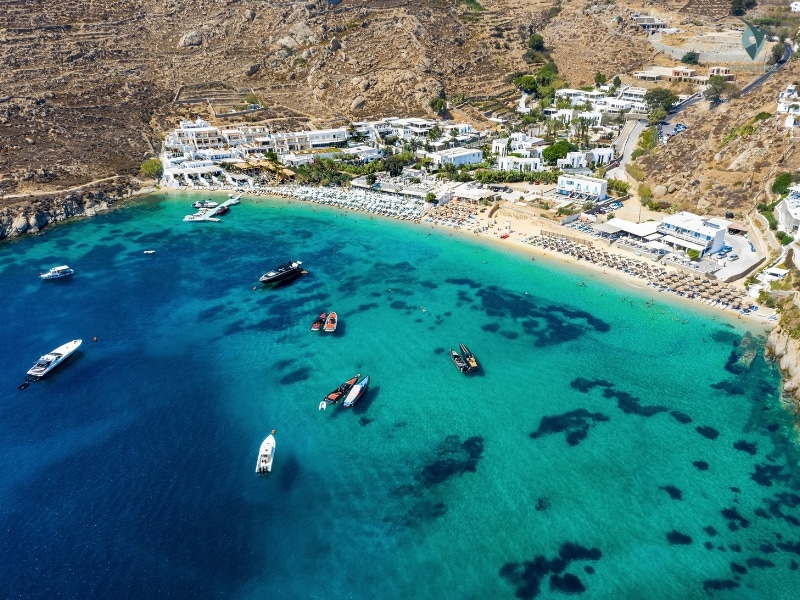Have you ever imagined exploring ancient ruins, enjoying Mediterranean sunsets, or tasting fresh olives right from the grove? I understand what it’s like, and I can guide you on how to enjoy your adventure to the fullest. This guide combines popular attractions in Athens with lesser-known treasures in the peaceful villages of the Peloponnese.
Table of Contents
ToggleMain Points
- Explore Athens’ famous sights and hidden local gems.
- Travel between islands easily with these simple ferry tips.
- Discover hidden gems outside of Santorini and Mykonos.
- Explore markets and enjoy meals at family-run tavernas.
- Pack wisely for walking on cobblestone streets and enjoying seaside adventures.
Reasons to Choose Greece as Your Next Destination
I’ve visited 44 countries, but none have amazed me like this one with its rich history. Walking through the ancient sites of Athens, such as the Acropolis, feels like being in a textbook—only this time, you are actually there, following in the footsteps of Socrates.

Just a short ferry ride away, Mykonos buzzes with DJ music and bright white buildings. Not many places combine ancient ruins with lively beach parties so seamlessly.
One evening, I saw the sun set behind the Parthenon, turning the marble columns a beautiful gold. That moment made the trip truly memorable. Is it even better? Beautiful beaches are only 45 minutes away from the centre of Athens. You can visit temples in the morning and enjoy swimming in the Aegean Sea in the afternoon.
The warmth of the locals really stands out. After visiting many places, I can say that the hospitality here is the best of all. Family-run tavernas welcome you warmly, making you feel like an old friend, while shopkeepers share stories as you make your purchase.
It’s a great idea to visit in May or September. You can avoid the summer crowds while still enjoying sunny days that are great for exploring ancient sites or relaxing on quiet beaches.
Creating Your Travel Itinerary for Greece
Choosing the right season and trip length can greatly affect your experience—here’s how to get both right. When you’re looking for peaceful villages or vibrant beaches, the right timing is important.
The ideal time to visit
April to June and September to October are the best times. You can escape the intense summer heat and crowds while still enjoying pleasant swimming weather. During my visit in July, I found myself waiting in lines more than actually exploring the temples.
Here’s a helpful tip: ferry schedules are less frequent in winter. If you are island-hopping, choose late spring or early autumn for dependable routes.
How many days do you need?
To experience history and islands, plan for a minimum of 7 days. Divide your stay with 3 nights in Athens and 2 nights on each of the two islands. Rick Steves’ 14-day route is perfect for those who want to explore the treasures of the mainland, like Delphi, along with some time to relax on the islands.
- A brief trip: 5 to 7 days (Athens plus one island)
- Explore for 10 to 14 days, including the Peloponnese or Crete.
Did I make a rookie mistake? Not giving enough time for the ferry. A 2-hour ride might take 5 hours if there are delays, so always allow extra time in your schedule!
Athens: A Blend of History and Today
The city is alive from sunrise at the Acropolis to late-night souvlaki runs. Athens is full of life—where else can you enjoy freddos beneath ancient marble columns that are 2,500 years old? My first visit felt like travelling through different times, and I’ve put together the best experiences into a three-day plan.

Days 1 to 3: Key Attractions
Begin your visit to the ancient sites early to avoid the crowds. The Acropolis opens at 8 AM. Go up early to enjoy views of the Parthenon before it gets too hot. After that, wander through the cobblestone streets of Plaka. The pastel buildings conceal artisan shops and family-owned tavernas.
Tip: Get a metro card at the airport (Line 3 goes straight to Syntagma). Be careful of pickpockets in crowded stations. To enjoy a green getaway, you can rent bikes close to the National Gardens. I spent an afternoon riding my bike by ancient Roman ruins and cosy cafes.
Accommodation Options
Plaka is central but can be noisy; Monastiraki has quieter streets that are just as charming. What’s my favourite choice? Selina Hotel is close to Koukaki. The rooftop yoga classes offer a perfect view of the Acropolis—definitely worth getting up for.
Looking for a ride? Use apps like Beat to avoid haggling with taxi drivers. They cost less and follow routes. In Psyrri, you can find affordable hostels that offer a creative atmosphere and a taste of the local culture.
Exploring the Greek Islands: Island-Hopping
As soon as I got off the ferry in Mykonos, I realised that island life was the adventure I had been looking for. Every island has its own rhythm—ranging from lively beaches with DJs to peaceful villages on the cliffs. Here’s how to find the key points.
Mykonos: Shores and Evening Fun
Mykonos is full of energy. Nammos Beach Club represents luxury with cocktails priced around €30, while quieter places like Agios Sostis provide free sunbeds. At night, the waterfront becomes an outdoor club.
It’s a good idea to book a ferry in advance. Fast options reduce travel time, but they are twice as expensive as regular boats. For a local feel, visit Scorpios at sunset. It may be expensive, but it’s an experience you won’t forget.
Santorini: Beautiful Sunsets and Relaxing Moments
The cliffs of Santorini are even more beautiful when you see them in person. Avoid the crowds in Oia and visit Akrotiri Lighthouse for stunning views. The red sand beaches close to Perissa are great for relaxing afternoons.
The ferry routes here are dependable, and flights from Athens only take 45 minutes. Travel light—cobblestone streets are not easy for suitcases.
- Attention: Beach clubs are charging over €50 for loungers. Public beaches such as Kamari are equally beautiful.
- Fira has charming backstreets where you can find family-run tavernas offering seafood feasts for just €10.
Discovering Unique Places Away from the Crowds
While many visitors gather at Santorini’s caldera, my best memories were made in less crowded places. The Peloponnese and lesser-known islands such as Milos provide quiet beaches, stunning scenery, and a glimpse into local life.
Kardamyli and Monemvasia in the Peloponnese
Kardamyli: Capes and Islands That Are Not Well-Known, Such as Milos Tower Houses and Olive Groves. Take a walk through the Vixos Gorge to enjoy stunning ocean views from the cliffs, and then relax at secluded beaches such as Foneas. Be sure to visit Medusa Taverna by the port—their grilled octopus is famous.
Further east, Monemvasia seems to be stuck in time. This village from the mediaeval times is free of cars and is situated on a rocky island. Stroll through its cobbled streets to visit Byzantine churches and small shops offering handmade honey.
- For a great experience, consider renting a car to discover the Peloponnese. Public transport is limited, and the coastal routes offer enjoyable leisurely drives.
- Discover a special place: Visit Areopoli for delicious buffalo-milk yoghurt topped with thyme honey.
Lesser-Known Islands Like Milos
The beaches of Milos, such as the moonlike cliffs of Sarakiniko, look like they belong in a science fiction movie. Reserve a boat tour to the sea caves of Kleftiko, where pirates used to hide their treasure. Here, you can enjoy the turquoise water with only a few other swimmers around.
- In Klima, the vibrant fisherman houses also serve as charming boutique guesthouses.
- Save money by packing a picnic from Adamas’ morning market—fresh figs are very affordable.
Travelling in Greece
Getting around here is both exciting and useful, whether you choose to travel by sea, air, or road. Every choice has its pros and cons—I’m here to help you choose the best one for your goals.

Ferries or Flights: Which is Better?
Ferries are well-known, but they move at a slower pace. The journey from Athens to Mykonos takes between 2 to 5 hours, depending on the type of boat you choose. Fast boats are twice as expensive, but they help you save time. Economy seats are simple, while business class provides comfortable lounges and views of the sea.
For short trips, flights are the best choice. Olympic Air and Sky Express provide flights to islands such as Santorini in just 45 minutes. However, airports have long security lines, and baggage fees can increase quickly.
- Tip: Book ferries in the early morning to steer clear of afternoon winds that can lead to delays.
- Save money: Look for flight deals during the off-season—Aegean Airlines has weekly sales.
Renting a Car: Advantages and Disadvantages
Freedom has its own unique traits. Most rental cars have manual transmissions, so it’s best to request automatic ones in advance. Toll roads make travel faster, but coastal routes such as the Peloponnese provide stunning scenic detours.
I found out the tough way: avoid basic insurance. I had to pay €300 out of my own pocket for a rock chip in Crete. Getting full coverage is worth the additional €10 per day.
- In villages, parking can be quite limited. Small cars fit nicely in tight spaces on the cliffs.
- The drive from Nafplio to Kalamata takes you through olive groves and along quiet beaches.
Where to Dine Like a Local
There’s nothing like enjoying crispy spanakopita while watching fishermen bring in their catch at dawn. To enjoy real flavours, avoid tourist spots and go where the locals queue. Here’s how to enjoy a meal as if you truly belong.
Begin at Athens Central Market. At 7 AM, butchers cut lamb while vendors arrange piles of olives. Pick up a koulouri (sesame bread ring) and enjoy watching the regulars discuss the freshest octopus of the day. For a great breakfast, don’t miss the strapatsada (scrambled eggs with tomato) at local tavernas—it’s a must-try.
In Mykonos, steer clear of the gold-steak trend. Instead, explore further past Little Venice to reach Kiki’s Taverna. This hidden gem cooks seafood over open flames. Get there by noon or wait an hour, but the smoky feta is definitely worth it.
- Enjoy a sunset wine tasting at Venetsanos Winery in Santorini. Their Assyrtiko white wine goes wonderfully with the views of the caldera.
- Olive oil from Peloponnese: Take a trip to the family groves in Kardamyli. Tours conclude with bread dipped in spicy oil—more memorable than any souvenir.
- Here’s a budget tip: upscale restaurants such as Funky Gourmet have lunch specials that cost half of what dinner does.
Small towns have the brightest treasures. In fishing villages such as Nafplio, tavernas offer garides saganaki (shrimp in tomato-feta sauce) directly on the dock. For dessert, follow the smell of baklava to hidden bakeries—just like I did in a quiet town in the Peloponnese.
Tips for Budgeting Your Trip to Greece
Making your money go further here doesn’t mean missing out on the fun—just making wiser choices. I’ve made the most of my trips, enjoying everything from hostel stays to discovering free hidden treasures. Here’s how to make your budget more effective.
Start by addressing accommodations. Staying during the off-season in April or October can reduce prices by 40%. Choose hostels instead of hotels, like Athens Backpackers. Their rooftop bars are just as good as more expensive places. During longer stays, Airbnb apartments usually have lower prices than hotels.
Travelling between islands can quickly become expensive. Choose slower ferries that cost half as much as speedboats. The cost to travel from Mykonos to Santorini is €25 on regular routes and €60 on high-speed options. Bring snacks because the food on the plane costs too much.
- Enjoy local flavours: Supermarket picnics (imagine spending €5 on cheese, bread, and olives) are a better choice than €30 lunches at a taverna. Save special treats for sunset dinners.
- Free adventures: Days at the beach are free. You can get a €30 combo ticket for Athens’ ancient sites, which lets you visit 7 locations over 2 days.
- For VAT refunds, keep your receipts for any purchases that cost more than €50. Airport kiosks offer refunds of 12–24%. Just make sure to arrive early to wait in the queue.
Spend wisely while enjoying treats. A day at the beach club for €50 is a treat; the rest can be done yourself. In Santorini, avoid the busy sunset locations in Oia. Visit Skaros Rock for stunning panoramic views at no cost.
Here’s a helpful tip: try using apps like Ferryhopper to check different routes. For nights under €50, look at smaller islands such as Naxos. Their family-owned guesthouses offer breakfast and helpful local advice.
Essential Items to Pack for Greece
After a week of walking on cobblestone streets and taking island ferries, I’ve figured out the essential items to pack. Believe me—blisters and sunburns showed me what is really worth packing in my suitcase.
Footwear is essential. Avoid weak flip-flops; choose supportive sandals like Birkenstocks instead. My feet made it through 10-hour days of exploring ruins because of these.
Reef-safe sunscreen protected my skin and helped the ocean. Local pharmacies have higher prices, so bring a 3-ounce bottle. Motion sickness pills are very helpful for ferry rides. Choppy waters can make a 2-hour journey quite uncomfortable.
- Evening outfits: Lightweight linen dresses or polo shirts move easily from the beach to the taverna.
- Important tech items include a universal adapter (Type C/F) and a compact charger to keep your devices powered during long layovers.
Tip: Roll your clothes to save space. Ferries can take a long time, so having a Kindle or downloaded playlists helps pass the time. Bring a foldable tote for trips to the market—it’s perfect for carrying olive oil and ceramics.
Safety and Cultural Respect
Understanding the cultural norms here is simpler than saying ‘Efharisto’—if you pay attention to the right things. After some small mistakes (like my flip-flop trouble at the Acropolis), I’ve figured out how to blend in and stay safe.
We should show respect for archaeological sites. At temples like the Parthenon, shoulders and knees should be covered. After being turned away, I learnt to always pack a lightweight scarf. Please do not touch the ruins, as fines for damaging historical landmarks are very high.
Dress codes change depending on the place:
- Beachwear is meant for the sand. Make sure to cover up when you leave coastal areas.
- Towns prefer a relaxed and stylish look. Choose linen pants instead of tank tops for dinner.
Many visitors find tipping confusing. Round up taxi fares or leave a tip of 5–10% at sit-down meals. Cafés? Only some loose coins. Pharmacies have a wide range of products, including sunscreen and medications. Just look for the green cross sign to find one. Keep these numbers safe:
- Call 112 for emergencies.
- 100 for the police
Pickpockets in the metro often target tourists who are not paying attention. Make sure your bags are zipped and your phones are put away. Here’s my trick. A crossbody purse with slash-proof straps is definitely worth the money.
One last lesson: cobblestones and flip-flops do not get along. After a shaky moment at Delphi, I traded mine for comfortable sandals. Your ankles will appreciate it.
Are you prepared for your Greek adventure?
With these helpful tips, you can now make your dreams come true. Make sure to review your plan: travel insurance, cash in euros, and comfortable shoes. If it’s your first time, focus on Athens and visit one island. Are there visitors coming back? Explore the Peloponnese or discover hidden treasures like Milos.
Pack wisely—bring light layers for spring and fall, and don’t forget sunscreen for summer. Allow space for unexpected moments. Many of my favourite memories began with unexpected stops at cliffside tavernas.
Are you prepared? Get that ferry ticket booked today. If you love history, beaches, or late-night souvlaki, your ideal trip begins now. Believe me, you’ll be planning your next visit before you even get back home.
FAQ
When is the ideal time to go for pleasant weather and less busy places?
Late spring, from May to June, and early autumn, in September and October, provide warm weather, fewer visitors, and more affordable prices. July and August are the busiest months—be prepared for more people and increased prices.
How many days should I stay in Athens?
Three days is perfect for discovering ancient sites such as the Acropolis, wandering through the lovely streets of Plaka, and enjoying local tavernas. If you want to explore history more deeply, consider adding an extra day.
Which islands are the easiest to visit together on one trip?
A ferry ride between Mykonos and Santorini takes three to four hours. For a more peaceful atmosphere, combine Milos with Sifnos—both offer beautiful beaches and delicious food.
Which is better for island-hopping: ferries or flights?
Ferries are less expensive and offer beautiful views, but they take more time. Flights are quicker (it takes 45 minutes from Athens to Santorini), but they are more expensive. Make sure to book your ferries early in the summer!
Is it a good idea to rent a car for exploring the mainland?
Absolutely! Public transport options are few outside of cities. A car allows you to explore hidden villages in the Peloponnese or enjoy scenic drives along the coast in Crete. Avoid narrow roads on the islands.
What is a local dish that I should definitely try?
Get moussaka, fresh grilled octopus, and loukoumades. Avoid crowded tourist areas—dine where the locals gather.
What are some ways to save money while still enjoying experiences?
Choose family-run guesthouses, use public ferries, and explore free ancient sites. Lunch specials at tavernas usually cost half as much as dinner.
What else should I pack apart from sunscreen and swimwear?
Wear comfortable sandals for walking on cobblestone paths, bring a light scarf for visiting churches, and carry a reusable water bottle since many towns offer free drinking fountains.
Is it safe for a woman to travel alone?
Absolutely! Stay in bright places at night and trust your instincts. Greeks are friendly—I’ve always felt at home, even in far-off places.







